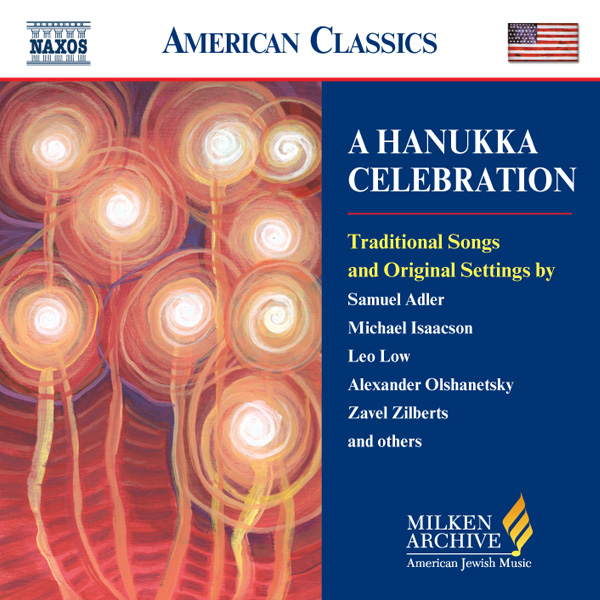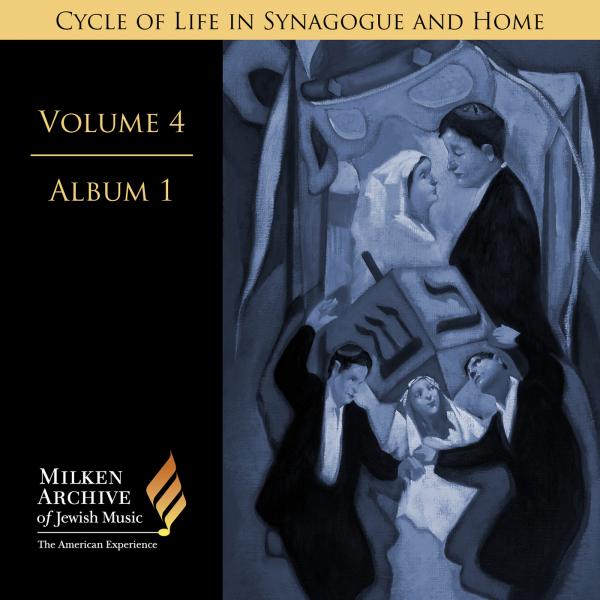Tracks
Liner Notes
The Hanukka ceremony on each of the eight nights commences with the rabbinically ordained kindling of the Hanukka candles or oil-burning lights, preceded by three benedictions and ending with two succeeding liturgical texts (hannerot hallalu and ma’oz tzur). The Hanukka lights were originally kindled only in the home, but were later introduced into the synagogue as well. There, it occurs immediately following the minḥa (afternoon) service on weekdays.
The benedictions and liturgy are generally sung at home with the assembled family and guests. However, additional public candlelighting ceremonies are well-established events often associated with Hanukka concerts. The tradition of annual Hanukka concerts dates to pre-20th-century Europe and has been perpetuated and even enlarged in many American communities. Cantorial-choral settings of the candlelighting benedictions have thus been created by composers and arrangers throughout the 20th century, in a wide variety of styles.
Two benedictions are recited (preferably sung) before the lights are kindled. The first one praises and acknowledges God for enabling the Jewish people to attain holiness (closeness to God) through observance of His commandments, which in the context of Hanukka extend to the postbiblical legal requirement to kindle the lights. Since the Hanukka episode is itself postbiblical, there is no reference to it in the actual Torah. Yet the wording of the first benediction, “Who [God] has commanded us to kindle the Hanukka lights,” is a reminder that religious obligations ordained by the sages—beginning with the “men of the Great Assembly” (anshei knesset hag’dola), the spiritual leaders in the period of Ezra the Scribe who are considered the prophets’ successors—have the same force of divine commandment in Jewish law and practice as those stated in the Torah.
The second benediction praises and acknowledges God for His role in ensuring the victorious outcome of the Hanukka episode—for His having “wrought miracles for our forefathers in those former times at this same season” (i.e., this date on the Hebrew calendar for the rededication of the Temple following the Maccabean victory). On the first night of Hanukka, the kindling ceremony includes a third benediction that is also recited on other occasions out of similar sentiment. It expresses gratitude for having been sustained and preserved thus far, and therefore able to reach and witness the current season.
Unlike certain other parts of the Ashkenazi liturgy, there is no single authoritative melody for the Hanukka benedictions. The b’rakhot l'hanukka (Benedictions for the Kindling of the Hanukka Lights), the first in a series of three benedictions, is a setting for cantor and choir by Raymond Goldstein that utilizes unrelated melodies by three traditional cantorial composers—Solomon Ancis; Joshua Lind; and Zeidl Rovner—the last two of whom were famous synagogue composers in the quintessential eastern European folk-oriented mold. Goldstein’s paraphrase here as a single unified setting evokes a typical traditional Hanukka concert or public candlelighting, but it is cleverly fused with a more contemporary harmonic character.
Hannerot hallalu, which underscores the exclusive function of the lights in recalling God’s miracles and wonders and His deliverance, is sung immediately after the lights are kindled. The admonition concerning the sanctity of the lights—and the prohibition of any profane or practical use other than simply looking at them—necessitates the use of a separate ninth flame (the shammash) to kindle the others. The preceding choral setting, Hugo Adler’s Hannerot hallalu, with its contrapuntal sections juxtaposed against more homophonic treatments, is appropriate for a public candlelighting ceremony.
The final benediction, ma'oz tzur, concludes the candlelighting ceremony with what is probably the most widely known Hanukka hymn text. It is sung after each light appropriate to the particular sequential night has been lit. The poem is thae creation of one “Mord’khai,” apparently a 13th-century Ashkenazi poet whose name appears as an acrostic in the initial letters of each of the five stanzas.
The text refers to four principal instances of deliverance of the Jewish people from its oppressors. The fifth and final stanza offers a twenty-four-word summary of the Maccabean struggle, along with the traditional legendary account of the miraculously burning oil. The singing of ma’oz tzur apparently was well established as part of the Hanukka candlelighting ceremony in western and west Central Europe by at least the early 15th century—and quite possibly much earlier.
Apart from two well-known versions, there are many alternative melodies for ma’oz tzur that have not gained wide currency. The present Ma'oz tzur by Cantor Aaron Miller is familiar only among the contemporary Bobover Hassidim, to which dynasty he belonged. While not, strictly speaking, a traditional Bobover tune, it exhibits the quintessential Bobover conviction that there is at least some measure of joy to be found in every human experience.
Lyrics
Sung in Hebrew
REBUILD THE TEMPLE, BRING ME HOME
My rock, my strength, my rescuer, it is a delight to praise You.
Repair, restore my House of Prayer.
There I will offer thanksgiving and sacrifice.
When punishment overcomes villainous foes, I will chant again that ancient psalm, and dedicate anew Your altar.
EGYPTIAN BONDAGE AND REDEMPTION
My soul became glutted with horrors, my strength was destroyed by grief, my life embittered by hardship—I’d become a slave in Egypt—that “Kingdom of the Calf."1
But with Your mighty arm You delivered Your special folk, and in the midst of the Sea of Reeds
Pharaoh’s legions and Pharaoh’s seed sank like stones into the deep.
BABYLONIAN EXILE AND REDEMPTION
God brought me to His holy sanctuary.
Even there I found no rest.
Oppressors came and exiled me, for I worshiped foreign gods and drank impure wine in strangers’ shrines.
I almost passed from history’s stage, but Babylonian exile could really end.
In seventy years came Z’rubavel and brought me back to my cherished home.
HAMAN'S THREAT AND ITS RESOLUTION
In Persia, Haman the Agagite sought to cleave God’s cypress tree—that is, to slay all Jews in Persia’s realm.
But this plot became Haman’s snare, his stumbling block.
You stilled his cruel arrogance, and led Mord’khai, of Benjamin’s tribe to save God’s folk.
You blotted out Haman’s name.
His followers—hanged, destroyed, and gone.
MACCABEAN VICTORY
In the days of the Hashmoneans pagan Greeks rallied to subdue me.
They breached the walls of my Temple’s towers, and defiled the oil reserved for worship.
You provided a miraculous feat for Your fragrant flower, Your people Israel: a remnant cruse of sacred oil overlooked by the pagan spoilers, sufficient for but one day’s use, lasted till new oil was found.
Eight nights of light shone for the Jews, the product of that one small cruse.
Then, teachers of wisdom, folk of discernment, issued a decree establishing a new festival for Jews:
Eight days, eight nights of Hanukka.
Eight days, eight nights of lights.
Eight days, eight nights of song, of joy, of hope.
1. Because the ancient Egyptians worshiped calves, the Midrash sometimes calls that country the Kingdom of the Calf.
Credits
Composer: Aaron MillerPerformers: Abba Bogin, Piano; Benzion Miller, Tenor
Arrangement: Neil Levin

